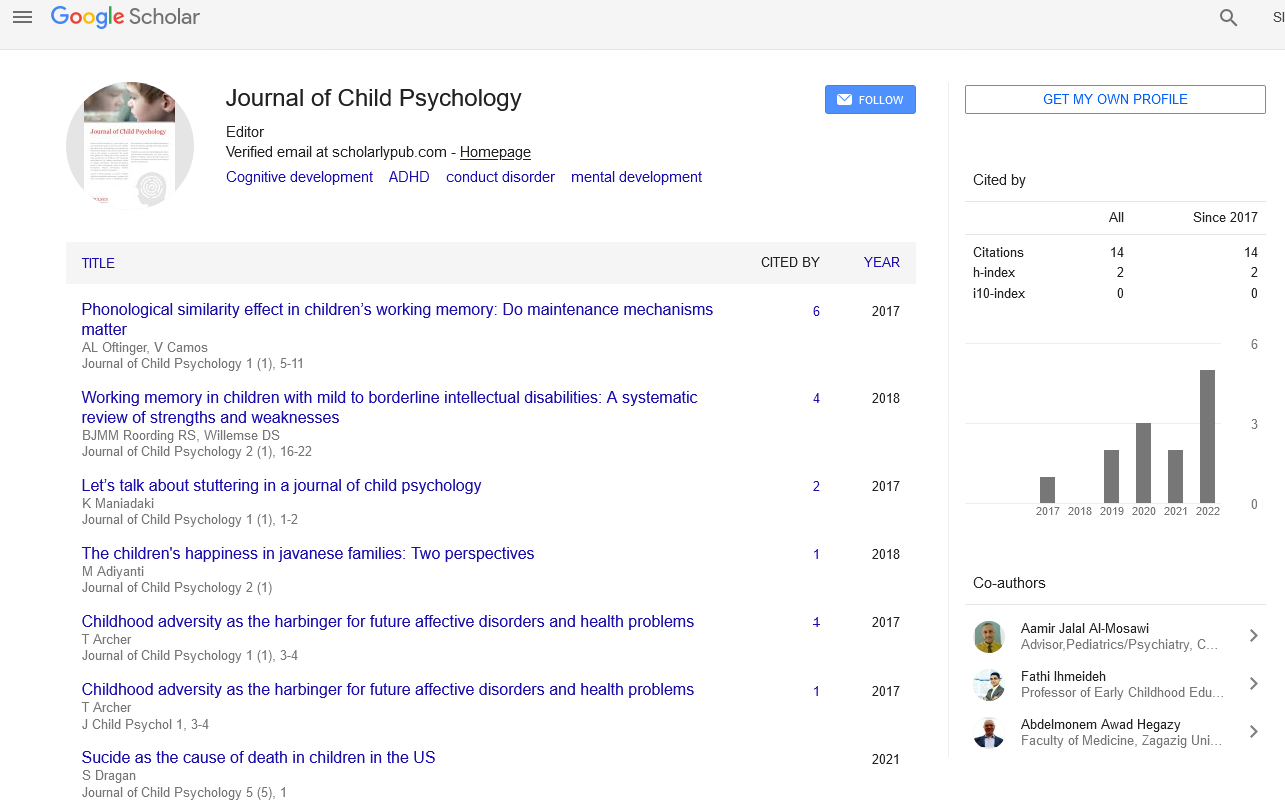Children's health-related quality of life: Age, gender, and interpersonal trust
Received: 27-Dec-2022, Manuscript No. PULJCP-22-6006; Editor assigned: 30-Dec-2022, Pre QC No. PULJCP-22-6006 (PQ); Accepted Date: Jan 17, 2023; Reviewed: 08-Jan-2023 QC No. PULJCP-22-6006 (Q); Revised: 12-Jan-2023, Manuscript No. PULJCP-22-6006 (R); Published: 27-Jan-2023, DOI: 10.37532/PULJCP.2023.7(1).7-8
Citation: Laessle R. Children's health-related quality of life: Age, gender, and interpersonal trust. J Child Psychol. 2023;7(1):7-8
This open-access article is distributed under the terms of the Creative Commons Attribution Non-Commercial License (CC BY-NC) (http://creativecommons.org/licenses/by-nc/4.0/), which permits reuse, distribution and reproduction of the article, provided that the original work is properly cited and the reuse is restricted to noncommercial purposes. For commercial reuse, contact reprints@pulsus.com
Abstract
Health care sciences and psychology are both interested in the topic of Health-Related Quality of Life (HRQoL). It is essential to gain a deeper understanding of the internal mechanisms underlying this effect using large samples in order to better comprehend HRQoL and formulate focused recommendations to enhance HRQoL. The goal of the current study is to examine how interpersonal trust, seen from a developmental lens, mediates the relationship between age and HRQoL. This study's objectives were to profile the Pediatric Quality of Life Inventory 4.0 generic scale in China, assess the association between age and health-related quality of life, and examine the mediating and moderating effects of gender and interpersonal trust. Measures of demographics, health-related quality of life, and interpersonal trust were completed by a sample of 6248 kids. The mediating function of interpersonal trust and the moderating role of gender were tested using regression analysis. Age was linked to reduced interpersonal trust and health-related quality of life. Similar gender differences were seen, with boys expressing lower interpersonal trust and higher health-related quality of life than girls. In addition, as they aged, girls' health-related quality of life decreased more than that of boys. Age could be predicted by a lower level of interpersonal trust, according to regression studies, which could lead to a lower health-related quality of life. Additionally, the gender difference in the mediation effect was attenuated, with boys experiencing a larger mediation impact than girls. The current study confirms age and gender differences in interpersonal trust and health-related quality of life.
Keywords
Children, Age, Gender
INTRODUCTION
A plan of action has been established for the creation of a healthy China in the Program for a Healthy China 2030, which was approved by the Political Bureau of the CPC Central Committee. Because HRQoL is a crucial requirement for national well-being and the cornerstone of economic and social progress, the programme strives to promote health, including HRQoL. Health-Related Quality of Life (HRQoL) is a multidimensional construct that can be characterised as an individual's perception of wellbeing in various spheres of life (including physical, psychological, and social components) in the context of their values, beliefs, expectations, goals, and cultural environment, reflecting their perceived physical and mental health over time. A plan of action has been established for the creation of a healthy China in the Program for a Healthy China 2030, which was approved by the Political Bureau of the CPC Central Committee. Because HRQoL is a crucial requirement for national well-being and the cornerstone of economic and social progress, the programme strives to promote health, including HRQoL. Health-related quality of life is a multidimensional construct that can be characterised as an individual's perception of wellbeing in various spheres of life (including physical, psychological, and social components) in the context of their values, beliefs, expectations, goals, and cultural environment, reflecting their perceived physical and mental health over time.
The turbulent physical and social changes that come with puberty in early adolescence, the urge for independence and separation from the family, and the change from elementary to middle school can all be problematic for kids and teenagers. Adolescents can lose confidence in themselves and slide into unhealthy outcomes when they are in environments (such as schools, homes, or community programmes) that are not tailored to their needs and traits. Knowing more about HRQoL in children and adolescents is very important for public health since it serves as the foundation for health-related quality of life and health in adulthood.
To better understand HRQoL and formulate focused recommendations to enhance HRQoL, larger samples are essential for gaining a deeper understanding of the internal mechanisms behind the development of HRQoL. Population studies found that children and adolescents' HRQoL varied by age. For instance, Bisegger and colleagues examined data on 3710 young people from seven different European nations and discovered that children and adolescents have different HRQoLs in several ways. Michel revealed that children generally had superior HRQoL than teenagers after analysing normative data on more than 21,590 children and adolescents from 12 European nations.
There is substantially more consistency in the research examining gender variations in HRQoL in children and adolescents. In particular, a study on the self-reported issues of kids aged 9 to 17 from seven European nations found that girls saw a higher decline in HRQoL than boys. Girls frequently score lower in HRQoL than their male counterparts, according to a second survey of youngsters from 12 European nations. Similar to this, Meade and Dowswell found that girls often score lower on the HRQoL scale than boys. In addition, Jalali-Farahani and colleagues discovered that in an Iranian setting, girls' self-reported and parent-reported HRQoL scores were considerably lower than boys'. It's possible that teenage physiological traits are related to gender differences. Girls are more concerned about their wellbeing than boys because they are in the early stages of menstruation, and because hormonal changes, the recurrence of traumatic life events, and particular coping techniques may cause mental health to deteriorate. Additionally, boys and girls approach situations differently. Therefore, the physiological systems and coping mechanisms of each gender may be connected to the gender difference in HRQoL. These findings imply that age and gender disparities were discovered across research and nations. However, a bigger sample size is required to confirm these results.





